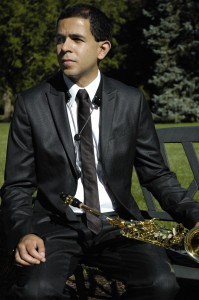De-emphasizing Meter: The Fanfare from Carter’s Canonic Suite for Saxophone Quartet
A presentation on the Fanfare which includes a detailed analysis of meter, the cognitive aspects that can be drawn from the movement and how they interact with the listener’s overall experience.

Biography
José A. Zayas Cabán is currently working on a DMA in Saxophone at the University of Iowa (Iowa City). He recently served as Assistant Professor of Music at Truman State University in Kirksville, MO. He is also He recently received a Performer’s Diploma from the Indiana University Jacobs School of Music (May 2009). He holds a Master of Music degree from the University of Minnesota (2007) as well as a Bachelor in Music and Bachelor of Arts from Truman State University (2005).
As a concert saxophonist, Mr. Zayas-Cabán has presented performances and taught master classes throughout Europe, the Caribbean and North America. He is also part of the Thursday Musical Morning Artist Series in Minneapolis, Minnesota.
More information
Abstract:
Elliot Carter is a composer known for and often associated with terms such as metric modulation and polyrhythm. Like in his second String Quartet, Carter is able to disassemble the content of a particular meter and reassemble it in such a way that a listener is able to experience uncommon groupings and rhythmic combinations. More importantly, Carter’s understanding of how to utilize multiple groupings within one work along with his knowledge of when these would overlap is a large part of the layering that can be attributed to his music. In essence, it is possible to argue that Carter prioritizes meter and rhythm as a way to draw musical content, whether it is tension and rest, accelerating and slowing down, etc, This focus allows for an innovative approach to the elements that listeners are accustomed to rely on for information on a work.
The focus of this paper is an earlier tonal work of Elliot Carter: Canonic Suite, written for four Alto Saxophones. In this paper, the first movement, Fanfare, is analyzed to demonstrate how Carter uses meter and tempo to create a continuous listening experience. This experience keeps the listener from perceiving the written meter. In combination with a homogeneous texture, the movement features an increasingly growing array of groupings, changes in articulation and other subtle features that steer the listener towards a rhythmically driven understanding of the movement.
In addition, the analysis is coupled with a comparison to Justin London’s research on metric perception based on tactus. This comparison further demonstrates that Carter’s performance tempo doesn’t allow the listener an opportunity to deduct groupings that can be associated with a particular time signature. Lastly, the analysis will show how compositionally, this is executed through a canon at the unison with entrances one quarter note apart. While a 2/4 time signature visually appears to allow for metric consonance, the way in which Carter employs his use of rhythm, tempo and groupings ultimately lead to another example of the rhythmic complexity and unique listening experience he is able to present the listener with.


 EN
EN FR
FR